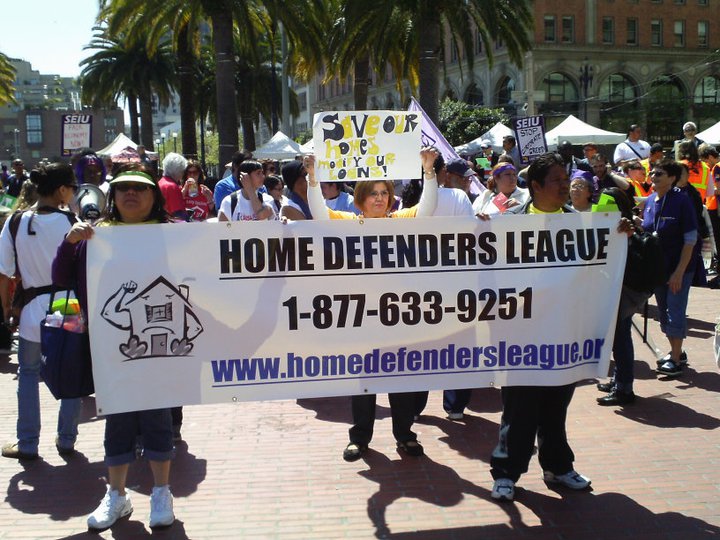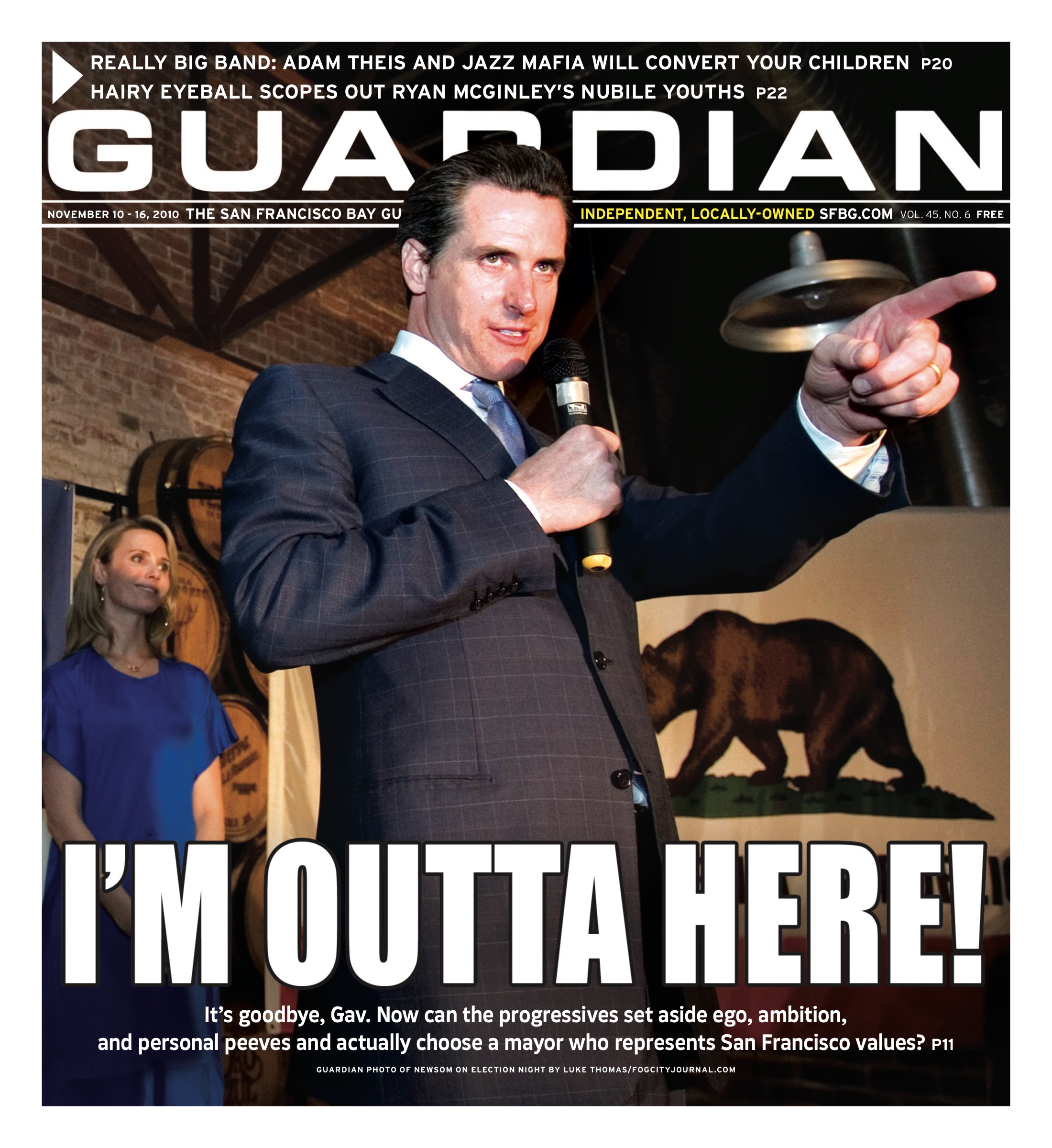ESSAY On opening night of Art Basel, N. Miami Avenue was a sort of Potemkin museum, every storefront packed with art, free wine and cheese, and the usually sleepy street clogged with taxis and limos. Ordinarily no one walks in muggy Miami, but tonight the cracked and littered sidewalks were deep with art patrons dressed in their Midtown Manhattan finery, looking out of place, as if passengers on a private jet that had made an emergency landing on a tropical Caribbean island. Wynwood is an area hard-hit by foreclosures. Up and down N. Miami Avenue, printed signs reading “Cash For Your Warhol” were nailed to the burned-out and boarded-up storefronts that remained untouched by Art Basel, a witty parody of the “Cash For Your Home” signs now popping up all over America’s inner cities.
Off the main drag on the dim side-streets, locals hustled cars into parking places in empty lots. With cheerful yet menacing Dade Country bravado, they ran the classic Miami scam of offering to “watch your car so that nothing happens to it” for $10. Just before Art Basel, newly released FBI crime statistics showed Miami had leapt to the fourth most violent city in the U.S., up from last year’s number 13. As I watched women in expensive heels stepping around a pair of scruffy, tan stray dogs, I reflected on some comments Craig Robins had made to me. When I asked the art mogul about the importance of Miami Vice to the redevelopment of Miami, he told me the 1980s TV show had “transformed the horror of the cocaine cowboy era, which was very real, into the fantasy of the cocaine cowboys, which was about sex appeal and fashion.” Miami’s brand name has always meant third world squalor skillfully repackaged as gritty charm.
“STREET,” “ART,” AND FAIREY TALES
Fittingly, much of the big-name art that served as the backdrop for Art Basel’s week-long street party in Wynwood was ephemeral street art that developer Tony Goldman and Deitch Projects commissioned for the outdoor exhibit, “Wynwood Walls.” Goldman, the famed developer of SoHo, was an early partner with a young and untested Robins in the ’80s and ’90s on South Beach. In 2005, Goldman bought 19 properties in Wynwood. Now, for Art Basel, in collaboration with Deitch, he was turning his warehouse exteriors into “a group of outdoor murals by the best artists in the field that will become an international street art museum.” Participating artists included the Brazilian twins Os Gemeos, SWOON, and most notably, Shepard Fairey of Andre the Giant/Obama Hope poster fame, who contributed an enormous piece on a wall in an empty lot on NW Second Avenue. SF artist Barry McGee also came to Miami to paint a tripped-out, fluorescent pattern of diamonds on an abandoned building farther down the block. Perhaps self-conscious of changing the neighborhood’s look too much, McGee added a wrecked, overturned car in the parking lot as part of the installation.
More “Wynwood Walls” murals by Kenny Scharf, AIKO, Clare Rojas, Jim Drain, and others could be found inside of a sort-of mural park made by opening a metal gate between two of Goldman’s warehouses. I spotted Goldman and Jeffrey Deitch standing together and grinning through the bars at the crowd inside, so I went up to talk to them. The two were something of an odd couple — Goldman relaxed and rumpled, Miami-in-December casual in shirtsleeves and ball cap; Deitch, his usual immaculate suit-and-tie self. Yet they seemed giddy and finished each other’s sentences like a couple in young love. I asked if there were plans to bring the graffiti museum indoors. “Who knows? “Right now — ” Deitch began, and Goldman waved his arm with a flourish and said, ” — we’re just happy to sit back and enjoy tonight.”
The murals on the streets and in the courtyard looked great. Yet, as visually arresting as many of these murals were, there was something about their appearance here in Miami that echoed the hollowness of the “pop-up” bar, Max Fish, that had come down from New York for the week. The Lower East Side bar had recreated an exact replica of itself in a previously abandoned storefront in Overtown just for the week of Art Basel. Similarly, “Wynwood Walls” was a “pop up” event that obscured the fact that the neighborhood had already long been famed for its illegal graffiti walls. Local graff heroes like CROME and CROOK had faced serious prison time for their art. Earlier in the year, a member of the notorious Miami graffiti crew the MSG Cartel died when he fell off a sign onto Highway I-95 while throwing up a tag. In this context, the new murals were corporate street art.
The cynical bait-and-switch in Miami’s stated goal to improve the city’s fortunes through hosting international art fairs was embodied neatly in Fairey’s work in Miami during Art Basel. His wall on NW 2nd Avenue was protected by an armed guard, 24 hours a day. I caught up with Fairey while he worked on another mural on N. Miami Avenue. He stood on a bucket and applied wheat paste while he held forth on the moral purity of street art. “People from Miami who have never seen my work before will be able to check this out,” he told me. “People aren’t intimidated by street art. They don’t need to go to a museum or have the right credentials for interpreting art to view it. If they don’t like it, they can just go up and tag it!”
“So why does your new mural have its own armed guard?”
Fairey stopped what he was doing, got down off the bucket, and looked me in the eye. “Look,” he said. “That wasn’t my idea. That’s Deitch’s [Deich Projects’] thing. If it was up to me, you’d just leave it up. If people tag it, you clean it off. But the mural is on panels, and Deitch wants to keep it clean because they’re going to move it later on.”
In other words, Fairey’s public street art for “Wynwood Walls” wasn’t really public at all. It only appeared to be public. But after the fair was over and the art world public had gone home, it would be moved indoors, possibly to a new graffiti museum, where it would be kept permanently or perhaps even sold.
SUSHI AND SHANTYTOWNS
Art Basel’s quest to absorb Miami’s street authenticity into its vortex continued a couple of blocks away in the middle of Midtown Miami Center, where New York/Miami/Tokyo Brazilian-Japanese fusion restaurant SushiSamba had spent $130,000 to install its own graffiti art show, Graffiti Gone Global.
Midtown Miami Center is a classic failed Miami real estate venture, at two years old an already fading outdoor mall. Its newly-built condos remain nearly half-empty, and many of the storefronts have never been occupied. (For Art Basel, Photo Miami hosted its photography exhibit in the storefront left vacant by the departure of Circuit City). “Graffiti Gone Global” reimagined an enormous, empty retail space by adding a shambling 25-foot-tall replica of a favela, a Brazilian shantytown – what the catalog called, “the infamous self-constructed housing units of the mountainsides in Brazil.” The towering model favela, covered in graffiti pieces, was surrounded by a two-dimensional cityscape of panels with photos of old Brooklyn storefronts, upon which the graffiti artists had also painted. Oddly, this fusion of fake New York and Latin American slums most evoked the feel of the temporary art fair outside on the real Miami streets. The program explained happily that “the favela installation will not only be used as a backdrop for works of art to be installed, but will also be sold as separate units — some even bearing a signature graffiti piece … allowing the viewer to see graffiti in its more natural setting.”
It was quite possible for the viewer to see actual favelas in their natural setting during Art Basel, too. Everyday during the art fair, thousands of art patrons taking the most direct route from the Miami Beach Convention Center to the art fairs of Miami via the Julia Tuttle Causeway drove past a sprawling tent city on the shores of Biscayne Bay just as you enter Miami. After leaving the SushiSamba show, I decided to pull over on the side of the road and check it out.
I counted 12 tents, seven cars, and a sturdy, and a handful of homemade wooden shacks arranged under palm trees along the shore. A long extension cord ran out of a tent toward a generator that sat in a clearing. At the end of the path, there was a café table with chairs around it, set up in the shade about six feet from shore, where I met Luis and Antonio. They told me there were about 100 men in the camp — almost all registered sex offenders who were unable to live anywhere else in Miami because of a strict new law prohibiting sex offenders from living within 2,500 feet of a school. In its fourth or fifth year, the camp has quasi-official government sanction — men are paroled out of prison directly to the camp and some even list “123 Julia Tuttle Causeway” as their address on their driver’s licenses. There was no water source or toilets, though the city came by once a month to pick up the collected garbage residents neatly stacked in bags by the causeway.
I did some mental calculation: the camp was certainly within 2,500 feet of SushiSamba’s fake shantytown. As I drove off, I say the camp in the rearview mirror, dwarfed by the silhouettes of new and half-empty condos in the distance, and I thought about another thing Robins had said about Miami: “It’s America’s city of the future.”
By Saturday, Dec. 5, the last gala night of Art Basel, it was clear that sales had rebounded from the previous year and that the art world was surviving the global economic collapse. Perhaps fittingly, the blue chip sale of the fair was Andy Warhol’s iconic screen print of that old cultural revolutionary, Mao, for $2.2 million by Van De Weghe Gallery. The message of the fair was clear: the market can absorb anything. It will prevail.
This same aura of indestructibility makes Art Basel seem impervious to cultural critique as well, though every year some artists still try. This year’s most notable attempt was “Littlest Sister,” an exhibit at Spinello Gallery. Modeled after the layout of the convention center floor, it turned the tiny Wynwood gallery into a series of booths, using Art Basel Miami Beach’s official gray-and-pink color scheme. Pieces in this “sister” fair, like Pachi Giustinian’s amusing Valve, poked fun at Art Basel or the art world itself. Valve was simply a compressor air-hose nozzle sticking out of the gallery wall — perfect for blowing up balloons of art fair hype. The enervating Art Forum Accident 2005 by Kristofer Paetau demonstrated the difficulty, though, of taking on the hot air of the large art fairs. The video depicted Paetau making himself projectile vomit on the floor of the 2005 Art Forum Fair in Berlin, among the world’s foremost galleries. The movement of the art dealers around Paetau freezes — but just for seconds. By the time one of them has led him to a chair and covered the puke with a couple sheets of paper, his action has been completely forgotten. The film ends with Paetau dry heaving, completely ignored by eager art buyers.
But the most provocative element in the exhibit was “Window Shopping Series,” a group of eight color photo portraits of Miami prostitutes taken on the streets. Artist Zach Balber told me that he intended the photos as a commentary on how artists are exploited by galleries. Balber paid each of them women $10 to pose, with the condition that if their portrait sold in the show, Balber would split the money with the woman and her pimp. “I wanted to flip the script on the collectors because I feel prostituted as an artist.”
Seen in this context, the photos were something of a cheap, sexist, juvenile prank. It would be impossible for any viewer to equate the 26-year-old white artist’s privileged suffering at the hands of art galleries to the degradation of life on the streets faced by the gaunt, toothless, and likely drug-addicted women Balber photographed. But the photos had a life of their own beyond the artist’s limited conception. They were perhaps the most haunting artwork I saw during the entire art fair. Balber had inadvertently invited the real world of Miami’s streets — the real favela — into the city of art. Despite their haggard appearance, the women had composed themselves with a certain quiet dignity for the camera, and the effect was to transfer the sense of voyeuristic shame that Balber should have felt onto the viewer, presumably a collector, who is roaming Miami’s shantytown streets only for the weekend. As they stared into the camera and, in turn, into Balber’s eyes, I saw the city of Miami itself looking back at the art world and asking, “Who really benefits from all this?”
In the end, artists that attempt to subvert Art Basel often simply add to its spectacle. On the last night of the fair, Brooklyn-based artist Molly Crabapple staged a hit-and-run event that promised “a guerilla live-drawing insurrection in South Beach”. Her Twitter communiqué announced a bold takeover of the Art Basel streets. “At exactly 8 p.m., a limo will disgorge a cavalcade of depraved performers — burlesque queens, dominatrixes, midgets — on the streets for you to draw.”
Crabapple is the accomplished illustrator and performer behind the highly successful Dr. Sketchy’s Anti-Art School, a series of live events/drawing classes usually held in bars or clubs, where burlesque dancers perform and are drawn by the audience. When I met up with her that night around 6 p.m. at the Art Whino fair, though, Crabapple was distraught and texting. Several of the performers had already canceled, and she was looking for a new location in Wynwood, having decided against taking on the upscale art world on South Beach. Finally, Crabapple rounded up four burlesque performers in colorful, spangle-y underwear, big wigs, and six-inch heels. They were joined by a dreadlocked fire dancer and the promised midget, who — with his cut-off sleeves, black hair hanging over his eyes, and excessive eye makeup — looked like a tiny Alice Cooper. The unlikely team looked like something out of an ’80s hair metal or wrestling video. Sadly, at the last minute, they were unable to rent a limo and had to settle for a rented SUV to take them to the event.
The SUV pulled over and blocked traffic around 8:15 on a side street in front of the Miami Aqua art fair. Crabapple paced around the car, calling out to the crowd that this street takeover was a performance of Dr. Sketchy’s Anti-Art School. The chauffer took pictures with his cell phone from the driver’s seat, while the four dancers and the midget assumed their first pose in the street in front of the car. With an audible “whoosh!” the fire dancer whipped his flaming torches on chains through the air, inches from the audience members’ faces. A crowd started to gather in a circle around the flames and the posing performers. The girls and the midget would stand absolutely still until Crabapple commanded, “Change!” and then would assume a new pose. When the notebooks were distributed through the crowd, the event at last made a bit of sense. It was actually pretty fun. My deformed stick figure drawing of the midget’s rugged pout, as seen through a veil of flames, serves now to remind me of the night when the fair drew to a close. When I see it, it is as if the camera is pulling back and the credits are starting to roll.
VANISHING POINT
Later that same night, I found myself at Max Fish. The fake bar had been hosting packed shows with live bands all week, and their Web site had posted notice of a Saturday-only “top-secret show tonight!” As the bar grew crowded, there was spirited debate about whether the top-secret guest would be Miami local Iggy Pop, last year’s Art Basel hit No Age, or someone else. I reflected that Max Fish the art installation had reached the height of its masterful success. This crowd was drinking in a bar that wasn’t even real, that wouldn’t be around the very next day, waiting to see a fantasy band that existed only in their mind.
Sometime after midnight the whole scene turned back into a pumpkin for me, though, when it became clear there was not going to be a show at all. As I walked back to Wynwood, the Overtown locals were still frantically hustling the last couple of trickle-down dollars out of the art fair tourists. I thought of the staring eyes of the women in Balber’s photos and wondered where they were tonight. I passed a construction site where a condo stood half-built or perhaps half-destroyed. It looked like art. Someone had nailed a “Cash For Your Warhol” sign to it.
On 22nd Street, as a stray dog trotted amiably past SWOON’s still-unfinished mural, I flashed back to Crabapple’s event and to the image that seemed to sum up the entire Art Basel week: four glamorous models and a rocker midget posing as if time had stopped, in front of a group of maybe 10 people trying with great concentration to draw them while they, too, were orbited by a much larger ring of perhaps 50 people taking photos of the people drawing the performers.
Half the mortgages in the state were underwater. Perhaps in a generation or two, due to rising sea levels, Miami would be too. From sandbar to paradise and back to sandbar in a century-long hallucination, a perfect work of art. What were the last words of the historians of Atlantis? I thought of Molly Crabapple’s parting words to the crowd that had gathered. As the girls and the midget got back into the SUV, promptly at 8:30, she waved her arm dramatically to the crowd and said, “Now we will vanish like a puff of smoke!”









